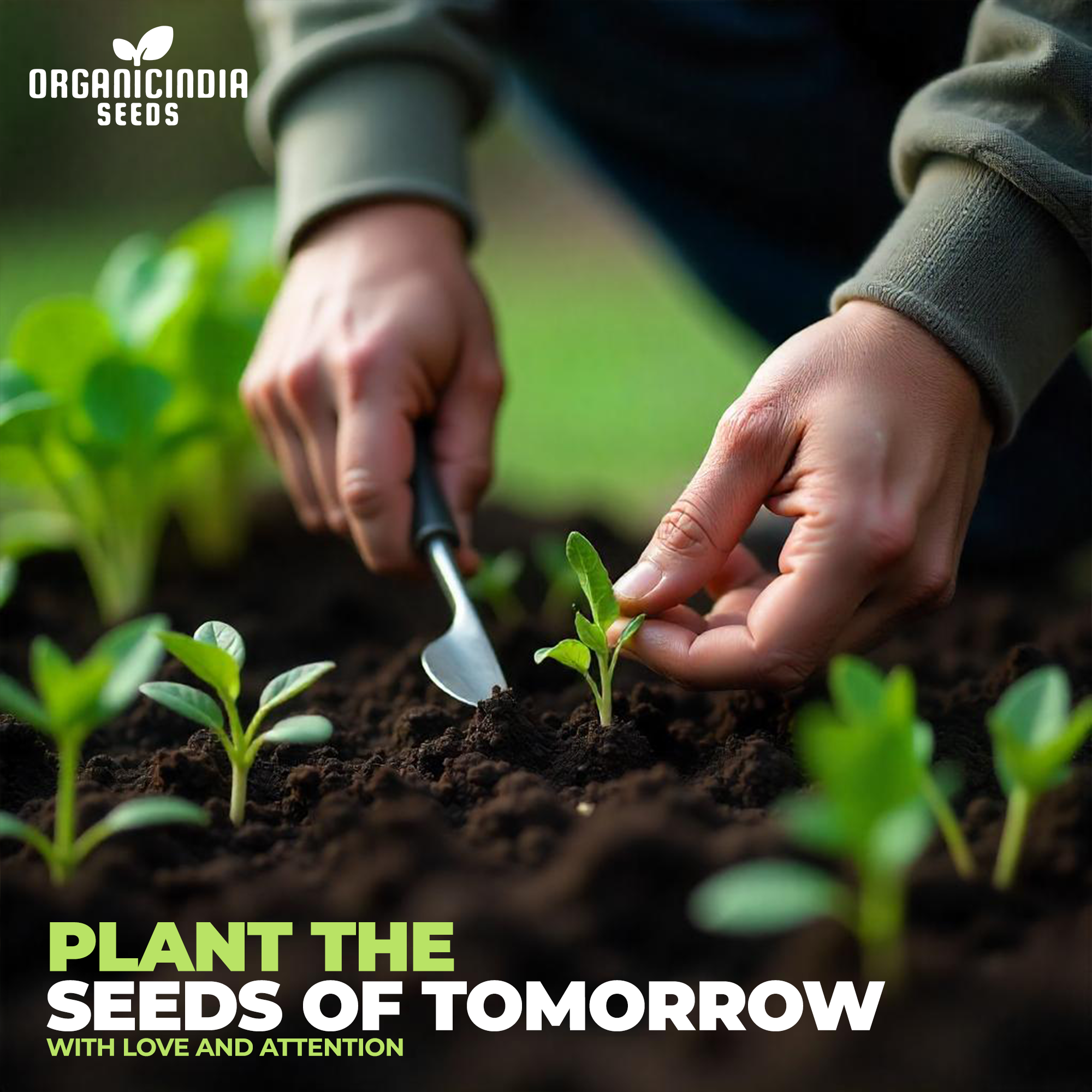Die 10 häufigsten Fehler beim Säen von Gemüse und Tipps, wie Sie diese vermeiden
Einen Gemüsegarten anzulegen ist ein spannendes Unterfangen, aber viele Anfänger stehen oft vor Herausforderungen, die ihren Erfolg behindern können. Wenn Sie häufige Fehler verstehen, können Sie einen blühenden Garten voller köstlicher Gemüsesorten wie Radieschen, Salat, Spinat, Karotten, Zucchini, Gurken, grüne Bohnen, Erbsen, Paprika und Tomaten anlegen. Hier sind einige häufige Fallstricke und wie Sie sie vermeiden können.
1. Überfüllung der Samen
Fehler: Wenn zu viele Samen zu dicht beieinander gepflanzt werden, kann es zu einem Wettbewerb um Nährstoffe, Licht und Wasser kommen. Dies gilt insbesondere für schnell wachsende Gemüsesorten wie Radieschen und Salat, die schnell zu groß für ihren Platz werden können.
Lösung: Halten Sie sich an die empfohlenen Abstände auf den Samenpackungen. Radieschen brauchen beispielsweise einen Abstand von 2,5 bis 5 cm, während Salat etwa 25 bis 30 cm Abstand haben sollte. Wenn Sie die Sämlinge früh ausdünnen, können Sie außerdem sicherstellen, dass jede Pflanze genügend Platz zum Wachsen hat.
2. Bodenqualität ignorieren
Fehler: Viele Anfänger unterschätzen die Bedeutung eines gesunden Bodens. Schlechter Boden kann zu Wachstumsstörungen und erhöhter Anfälligkeit für Schädlinge und Krankheiten führen.
Lösung: Investieren Sie in hochwertige Bodenverbesserungsmittel wie Kompost oder gut verrotteten Mist. Für Wurzelgemüse wie Karotten und Radieschen ist lockerer, gut durchlässiger Boden entscheidend. Führen Sie eine Bodenprobe durch, um den pH-Wert und den Nährstoffgehalt zu bestimmen, und verbessern Sie den Boden entsprechend.
3. Pflanzen zur falschen Zeit
Fehler: Jedes Gemüse hat eine bestimmte Wachstumsperiode und wenn man es zu früh oder zu spät pflanzt, kann das zum Misserfolg führen. Spinat und Erbsen gedeihen beispielsweise bei kühleren Temperaturen, während Tomaten und Zucchini wärmeres Wetter bevorzugen.
Lösung: Informieren Sie sich über die lokale Anbauzone und die saisonalen Zeiträume für jedes Gemüse. Verwenden Sie einen Pflanzkalender, um Ihre Aussaattermine festzulegen. Achten Sie auf die lokalen Frostdaten und pflanzen Sie entsprechend.
4. Vernachlässigung des Bewässerungsbedarfs
Fehler: Über- oder Unterwässerung kann Ihren Pflanzen erheblichen Schaden zufügen. Gurken und Zucchini beispielsweise benötigen konstante Feuchtigkeit, während Radieschen und Spinat verfaulen können, wenn sie in feuchter Erde stehen.
Lösung: Bewässern Sie Ihren Garten früh am Morgen, um die Verdunstung zu minimieren. Verwenden Sie ein Feuchtigkeitsmessgerät, um den Feuchtigkeitsgehalt des Bodens vor dem Gießen zu überprüfen, und zielen Sie auf tiefes, seltenes Gießen ab, um starke Wurzelsysteme zu fördern.
5. Fehlende Fruchtfolge
Fehler: Wenn jedes Jahr dasselbe Gemüse an derselben Stelle angebaut wird, kann dies zu Nährstoffmangel und vermehrten Schädlingsproblemen führen. Wenn beispielsweise Tomaten wiederholt an derselben Stelle angebaut werden, kann dies zu Krankheiten wie Kraut- und Knollenfäule führen.
Lösung: Üben Sie Fruchtwechsel, indem Sie Ihre Gemüsefamilien jede Saison wechseln. Lassen Sie beispielsweise auf Hülsenfrüchte wie Erbsen und grüne Bohnen, die Stickstoff im Boden binden, stickstoffhungrige Pflanzen wie Paprika und Tomaten folgen.
6. Vernachlässigung der Schädlingsbekämpfung
Fehler: Schädlinge können in einem Garten verheerende Schäden anrichten, wenn sie nicht richtig bekämpft werden. Häufige Übeltäter sind Blattläuse, Schnecken und Raupen, die empfindliche Setzlinge und ausgewachsene Pflanzen gleichermaßen schädigen können.
Lösung: Beobachten Sie Ihre Pflanzen regelmäßig auf Anzeichen von Schädlingen und ergreifen Sie frühzeitig Maßnahmen. Verwenden Sie natürliche Abwehrmittel wie Neemöl oder insektizide Seife und ziehen Sie Mischkulturen in Betracht (z. B. indem Sie Ringelblumen mit Tomaten pflanzen), um Schädlinge auf natürliche Weise abzuwehren.
7. Keine Unterstützung für Kletterpflanzen
Fehler: Pflanzen wie grüne Bohnen und Tomaten benötigen beim Wachsen möglicherweise Unterstützung. Wenn keine Spaliere oder Käfige bereitgestellt werden, kann dies zu ausufernden Pflanzen und geringeren Erträgen führen.
Lösung: Installieren Sie beim Pflanzen Stützsysteme. Bei grünen Bohnen kann ein einfaches Spalier Wunder wirken, während Tomaten von stabilen Käfigen oder Pfählen profitieren können. Dies hält die Pflanzen vom Boden fern, verbessert die Luftzirkulation und verringert das Krankheitsrisiko.
8. Sonnenlichtbedarf ignorieren
Fehler: Einige Gemüsesorten, wie Paprika und Tomaten, brauchen volle Sonne (mindestens 6–8 Stunden), um zu gedeihen, während andere, wie Spinat, Halbschatten vertragen.
Lösung: Beobachten Sie Ihren Garten den ganzen Tag über, um die Sonneneinstrahlung zu ermitteln. Gruppieren Sie Pflanzen entsprechend ihrem Sonnenlichtbedarf, indem Sie sonnenliebende Pflanzen an die hellsten Stellen stellen und schattentolerante Pflanzen dort, wo sie gedeihen können, ohne zu verbrennen.
Abschluss
Beim Gärtnern lernt man viel, und Fehler gehören dazu. Indem Sie diese häufigen Fehler vermeiden, können Sie in Ihrem Gemüsegarten Erfolg haben. Mit der richtigen Planung und Pflege sind Sie auf dem besten Weg, eine reiche Ernte an Radieschen, Salat, Spinat, Karotten, Zucchini, Gurken, grünen Bohnen, Erbsen, Paprika und Tomaten zu genießen. Viel Spaß beim Gärtnern!



Hinterlasse einen Kommentar
Diese Website ist durch hCaptcha geschützt und es gelten die allgemeinen Geschäftsbedingungen und Datenschutzbestimmungen von hCaptcha.